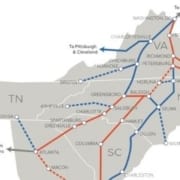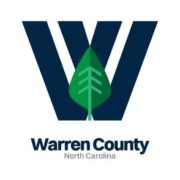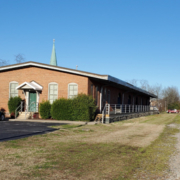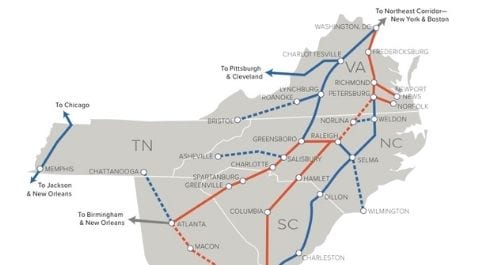The S-Line rail corridor goes straight through downtown Henderson. The future of the route from Petersburg, Virginia down to the Virginia line and then the NC Department of Transportation’s portion from Virginia to South Carolina could spawn additional economic development for the local Henderson area.
Being a mainline portion of the Southeast Corridor and possibly a higher speed line would help too.
For now, the news is the fact that NCDOT has been awarded a grant for development planning near passenger rail stations.
Henderson Mayor Eddie Ellington is quoted in a press release from NCDOT, and he said, “Our community was founded on rail traffic in 1841. It is only natural that our resurgence is based on this same driving force for economic development, connecting us to greater opportunities. The regional cooperation and resulting benefit this project represents is government at its best.”
Julie White, NCDOT’s deputy secretary for Multimodal Transportation said in the press release: “We’re grateful to be working with cities and towns that understand how passenger rail service can spur economic development. This as a great opportunity to use passenger rail to better connect rural and urban communities. It should serve as a model for future projects.”
In our area, Henderson and Franklinton contributed the necessary matching funds for the grant.
Franklinton Mayor Art Wright is quoted in the press release saying, “The Town of Franklinton is looking forward to working with our neighbors along the S-line to develop a community that will support passenger rail. This funding will promote Franklinton’s rich rail history and expand downtown.”
The grant money can be used to develop plans for areas around rail stations.
In Henderson, that plan will need to look at plans for the actual rail station itself. The only actual passenger station along the line is long gone, and the metal and plexiglass hut that sat at the corner of Williams and Montgomery Streets downtown was removed after the final AMTRAK operated “Silver Star” departed for the final time in the mid 1980s.
The bigger picture is all these smaller pieces are adding up. This grant now, and the next press release about another grant later, and when the news of hiring a new Henderson-Vance Downtown Development Commission director comes, and with the recent hiring of a new Henderson-Vance Economic Development Commission director, and downtown Main Street status in Henderson, and an expanded industrial park, and other growth and development, it’s all chipping away at the problem and putting down new roads to success.
If you’d like to hear more about the S-Line, listen back to TownTalk from October 28, 2020 and NCDOT guest Jason Orthner, Rail Division Director.
— NCDOT Press Release
NCDOT Awarded Grant for Development Planning Near Passenger Rail Stations
Federal funding will help communities plan for development on S-Line corridor
Raleigh — The Federal Transit Authority has awarded the N.C. Department of Transportation’s Integrated Mobility Division a $900,000 grant to help Triangle area communities create plans for development along the S-Line rail corridor.
The S-Line corridor is a passenger rail line that starts at the Virginia border, runs through Raleigh, and ends at the South Carolina state line.
“We’re grateful to be working with cities and towns that understand how passenger rail service can spur economic development,” said Julie White, NCDOT’s deputy secretary for Multimodal Transportation. “This as a great opportunity to use passenger rail to better connect rural and urban communities. It should serve as a model for future projects.”
The following towns contributed matching funds for the grant: Apex, Franklinton, Henderson, Raleigh, Sanford and Wake Forest. The towns will use the grant money to develop plans for the areas around the rail stations. The plans will explore how the rail stations will bolster economic development in their town centers and enable these communities to plan for connections to bus service, micro transit, bicycle paths and greenways.
Mayors of the towns that contributed matching funds to the grant provided the following comments.
Apex Mayor Jacques K. Gilbert said:
“The Town of Apex is thrilled to join the North Carolina Department of Transportation and our regional partners in this forward-thinking effort to plan for the future of passenger rail along the S-Line corridor. Working together, we will realize the substantial economic and mobility benefits of passenger rail for our communities.”
Franklinton Mayor Art Wright said:
“The Town of Franklinton is looking forward to working with our neighbors along the S-line to develop a community that will support passenger rail. This funding will promote Franklinton’s rich rail history and expand downtown.”
Henderson Mayor Eddie Ellington said:
“Our community was founded on rail traffic in 1841. It is only natural that our resurgence is based on this same driving force for economic development, connecting us to greater opportunities. The regional cooperation and resulting benefit this project represents is government at its best.”
Raleigh Mayor Mary-Ann Baldwin said:
“This grant is crucial to moving the S-Line project ahead and restoring passenger rail service between Raleigh and Richmond. In the long-term, the S-Line will improve mobility and reduce congestion, not only in Raleigh, but across the region. I am thrilled to continue working with everyone involved in this project, and deeply appreciate FTA’s support.”
Sanford Mayor Chet Mann said:
“Sanford is thrilled with the prospect of having passenger rail on the S-Line. We have a rich train history as we were founded at the rail crossing in 1874 in what is now our Depot Park. We see multimodal transportation as a key component to any growing community. This project will usher in a new wave of economic development around an area in our town already designated for revitalization. We are grateful to be partnering with the NCDOT and all the other stakeholders involved in this project and we are beyond excited at watching what happens as this project evolves.”
Wake Forest Mayor Vivian A. Jones said:
“We’ve been working on bringing passenger rail to Wake Forest for quite a while. We recognize there’s a strong demand out there, so we are excited about this opportunity and are looking forward to getting it done.”






